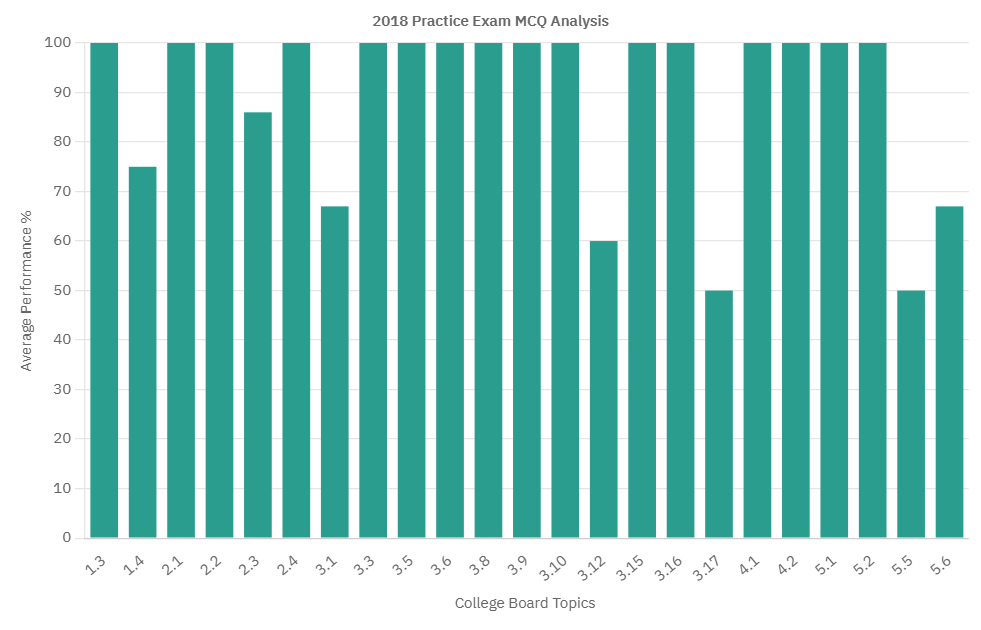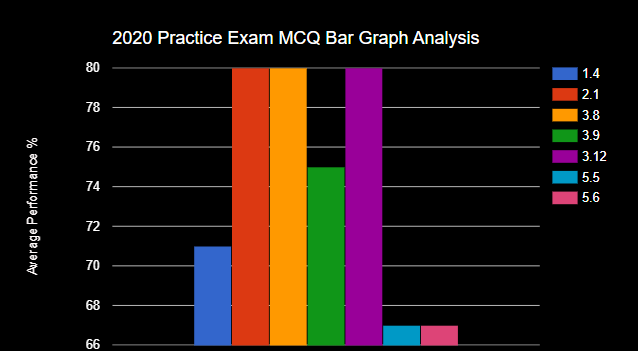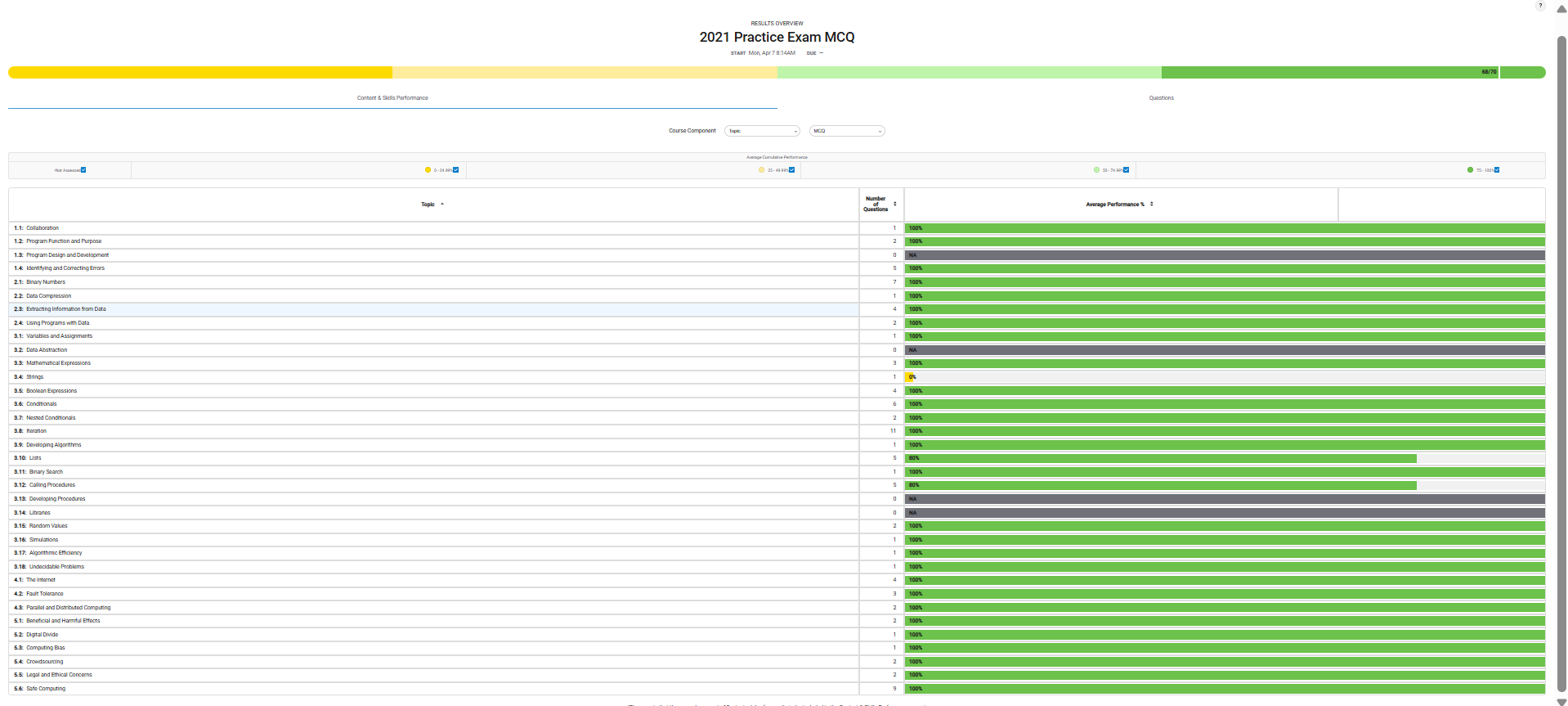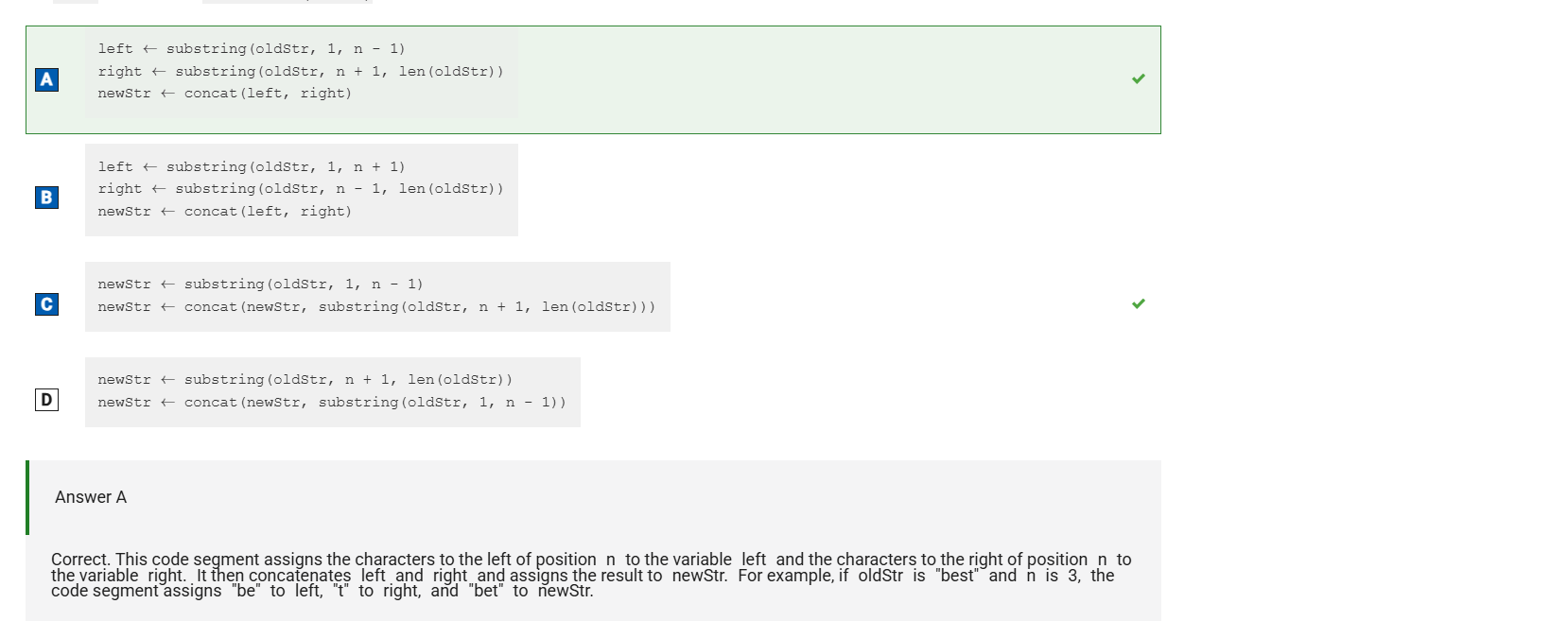Study Blog 4/23
My progress through CSP
- MCQ Reflection
- Total Score: 59/67
- Missed Topics:
- Improved Topics:
- Reoccurring Topics:
- New Topics:
- Topic 1.4 (Skill 4.C: Identify and Correct Errors)
- Topic 2.1 Binary Numbers (Skill 2.B: Develop and Implement Algorithms)
- Topic 3.8 Iteration (Skill 2.B: Develop and Implement Algorithms)
- Topic 3.9 Developing Algorithms (Skill 1.D: Evaluate Solution Options)
- Topic 3.12 Calling Procedures (Skill 3.B: Develop Programs that Incorporate Abstractions)
- Topic 5.5 Legal and Ethical Concerns (Skill 5.E: Evaluate the Use of Computing Based on Legal and Ethical Factors)
- Topic 5.6 Safe Computing (Skill 5.D: Describe the Impact of Gathering Data)
- 📅 May 1 (Thursday): Lists and Strings
- 📅 May 2 (Friday): Functions and Parameters
- 📅 May 3 (Saturday): Algorithm Thinking
- 📅 May 4 (Sunday): Abstraction and Debugging
- 📅 May 5 (Monday): Cybersecurity & Phishing
- 📅 May 6 (Tuesday): Mini Practice MCQ Test
- 📅 May 7 (Wednesday): Ethics and Computing Impacts
- 📅 May 8 (Thursday): Big Idea 3 – Programming
- 📅 May 9 (Friday): Big Idea 2 – Data
- 📅 May 10 (Saturday): Big Ideas 1, 4, and 5
- 📅 May 11 (Sunday): Full-Length MCQ Exam
- 📅 May 12 (Monday): Focused Review
- 📅 May 13 (Tuesday): Final Recap
- 📅 May 14 (Wednesday): Cool-Down Day
MCQ Reflection
Total Score: 59/67
- Time spent: 02:48:34
- Previous Score: 53/66


Missed Topics:
- 1.4
- 3.1
- 3.12
- 5.5
- 5.6
- 3.8
- 3.9
Improved Topics:
- 2.3
- 3.1
- 3.17
Reoccurring Topics:
- 1.4
- 3.1
- 3.12
- 5.5
- 5.6
New Topics:
- 3.8
- 3.9
Missed Questions:
Topic 1.4 (Skill 4.C: Identify and Correct Errors)
- Score: 5/7
- Q64, Q66
- Takeaways:
Evaluate all options. I have a general idea of the answers because I got at least one question correct, but I need to be more careful when evaluating the second option and should read all choices rather than finding an option and moving on. Review questions 16, 39, 54, 58, 67, because I got those right, and rewatch 1.4 Daily AP Videos 1-3.
Topic 2.1 Binary Numbers (Skill 2.B: Develop and Implement Algorithms)
- Score: 4/5
- Q11
- Takeaways:
No need to convert everything to binary; you can just evaluate the triplet using process of elimination.
Topic 3.8 Iteration (Skill 2.B: Develop and Implement Algorithms)
- Score: 6/7
- Q18
- Takeaways:
Make sure you’ve clicked the right option.
Topic 3.9 Developing Algorithms (Skill 1.D: Evaluate Solution Options)
- Q15
- Takeaways:
Program A initializes i to 1. Inside the loop, it prints i and then increments i. The loop terminates when i is greater than 10, which occurs after 10 is printed. Program A prints 1 2 3 4 5 6 7 8 9 10. Program B initializes i to 0. Inside the loop, it increments i and then prints i. The loop terminates when i equals 10, which occurs after 10 is printed. Program B prints 1 2 3 4 5 6 7 8 9 10.
Topic 3.12 Calling Procedures (Skill 3.B: Develop Programs that Incorporate Abstractions)
- Q60
- Takeaways:
This code segment creates newList1, containing the unique elements from list1, and newList2, containing the unique elements from list2. These two lists are combined to form bothList. Any elements that appear in both lists are removed from bothList to form uniqueList. The correct count is the difference between the lengths of bothList and uniqueList. For example, assume that list1 contains [10, 10, 20, 30, 40, 50, 60] and list2 contains [20, 20, 40, 60, 80]. The first line of code creates newList1, which contains [10, 20, 30, 40, 50, 60]. The second line of code creates newList2, which contains [20, 40, 60, 80]. The third line of code creates bothList, which contains [10, 20, 30, 40, 50, 60, 20, 40, 60, 80]. The fourth line of code creates uniqueList, which contains [10, 20, 30, 40, 50, 60, 80]. Since bothList contains 10 elements and uniqueList contains 7 elements, the correct result 3 is assigned to count.
Topic 5.5 Legal and Ethical Concerns (Skill 5.E: Evaluate the Use of Computing Based on Legal and Ethical Factors)
- Q51
- Takeaways:
Creative Commons licensing allows copyright owners to specify the ways in which their works can be used or distributed. This allows individuals to access or modify these works without the risk of violating copyright laws.
Topic 5.6 Safe Computing (Skill 5.D: Describe the Impact of Gathering Data)
- Q48
- Takeaways:
Phishing is a technique that is used to trick a user into providing personal information. In this case, the user is tricked into providing a username and password to an unauthorized individual posing as a technical support specialist.
Plan:
Revise AP Daily Videos and Read Fiveable Study Guides on:
- 1.4
- 3.1
- 3.12
- 5.5
- 5.6
- 3.8
- 3.9

Big Idea / Unit Weight on MCQ Section
- Creative Development 10–13%
- Data 17–22% (MISSED)
- Algorithms and Programming 30–35% (MISSED)
- Computer Systems and Networks 13–18%
- Impact of Computing 21–26%
Struggled Past Topics Topics:
These are the areas I consistently missed or had trouble with across multiple exams:
1.4 – Identifying and Correcting Errors: I need to be more careful when evaluating all the options instead of jumping on the first one that looks right. Even though I did okay, I missed a couple of questions due to rushing.
3.1 – Variables and Assignments: This came up again as a weakness. Even though I improved a bit, I still missed some questions here, which shows I haven’t fully nailed the basics.
3.12 – Calling Procedures: I misunderstood the logic in a code segment that involved list operations. I need to review this more deeply, especially the flow of data through function calls.
5.5 – Legal and Ethical Concerns: I missed a question on Creative Commons. I understood the general idea but didn’t apply it properly in context.
5.6 – Safe Computing: I got a phishing question wrong. It was a simple mistake, but it highlights the need to pay more attention to real-world computing impacts.
New Topics I Missed: These topics are new to my list of errors, so I clearly need more exposure to them:
3.8 – Iteration: I clicked the wrong option — probably just a misclick, but I’ll still go back and double-check I’m confident here.
3.9 – Developing Algorithms: I got confused between two very similar programs. I need to slow down and trace code more carefully.
Topics I Improved In: These were previously weak areas where I saw a noticeable improvement:
2.3 – Logical Operators: I’ve clearly done some good work here — I’m now consistently getting these right.
3.1 – Variables and Assignments: I’ve improved, but I’m not out of the woods yet.
3.17 – Lists and Traversals: Happy to see growth here — I’ve become much more confident navigating list structures.
Plan Going Forward: To strengthen my performance, I’ll focus on reviewing:
1.4, 3.1, 3.12, 5.5, 5.6, 3.8, and 3.9
I’ll rewatch the AP Daily Videos, especially for 1.4 (Videos 1–3), and read through the Fiveable Study Guides for each topic I missed. I’ll also revisit the questions I got wrong and the ones I got right but felt unsure about, to solidify my understanding.
 _________________________________________
_________________________________________

Prior to this exam, I purchased an AP Computer Science Principles Prep Book, which I studied in addition to the lessons we went over. The book details the Major AP CSP concepts and I found it really helpful, I spent a lot of time on this MC and that’s because I don’t feel really confident in the topics and I was distracted. I spent lots of time second guessing myself. So going forward I will take more practice tests, such as the ones included in the book.
🧠 AP CSP Exam Study Blog: My Road to Review & Readiness
I will use this blog to track my AP Computer Science Principles exam prep, reviewing each major topic day by day. My goal is to focus on quality over quantity and build confidence before test day. Every task listed below will help me sharpen key skills and reinforce core concepts.
🔷 April 25 (Friday): Pseudocode & Program Design
- I will watch a Khan Academy lesson on the programming process and pseudocode (10 min).
- I will walk through 3 pseudocode examples using conditionals and user input (20 min).
- I will complete a short FRQ on program design (30 min).
🔷 April 26 (Saturday): Binary & Data Representation
- I will review how text and images are stored as binary (10 min).
- I will practice converting binary to decimal and vice versa (15 min).
- I will watch a video on lossy vs. lossless compression (5 min).
- I will complete 6 MCQs on data storage and compression (30 min).
🔷 April 27 (Sunday): Metadata, Bias, & Big Data
- I will watch a Khan Academy clip on metadata and big data (10 min).
- I will read a short article or summary on algorithmic bias (10 min).
- I will write a brief reflection on how data can be biased and how to fix it (10 min).
- I will answer 6 MCQs on data ethics and privacy (30 min).
🔷 April 28 (Monday): Internet Basics & Protocols
- I will watch videos on how the Internet works (IP, TCP, DNS) (15 min).
- I will sketch a diagram showing how packets move through the Internet (10 min).
- I will answer 5 MCQs on protocols, redundancy, and fault tolerance (20 min).
- I will review how HTTPS protects data with SSL/TLS (15 min).
🔷 April 29 (Tuesday): Boolean Logic & Conditionals
- I will watch a video on Boolean expressions and logic (10 min).
- I will trace 3 code examples using
if-elsestatements (20 min). - I will solve 5 MCQs on logic and control flow (15 min).
- I will identify an abstraction used in a sample FRQ (15 min).
🔷 April 30 (Wednesday): Loops and Iteration
- I will review for-loops and while-loops using visual diagrams (10 min).
- I will trace nested loops by hand (15 min).
- I will write a loop that processes a list (15 min).
- I will complete 5 MCQs on iteration (20 min).
🔷 May 1–7: Programming Practice + Impact Topics
📅 May 1 (Thursday): Lists and Strings
- I will review accessing and modifying list elements (15 min).
- I will write a loop that filters a list (15 min).
- I will solve 6 MCQs on lists and indexing (30 min).
📅 May 2 (Friday): Functions and Parameters
- I will review how functions and return values work (10 min).
- I will write a function that takes and uses parameters (15 min).
- I will complete an FRQ analyzing function behavior (20 min).
- I will watch a short video on abstraction (15 min).
📅 May 3 (Saturday): Algorithm Thinking
- I will review linear and binary search algorithms (10 min).
- I will manually trace through a sorting problem (15 min).
- I will solve 8 MCQs on sorting and searching (35 min).
📅 May 4 (Sunday): Abstraction and Debugging
- I will identify abstraction layers in 3 code examples (15 min).
- I will debug logic errors in a nested function (15 min).
- I will complete an FRQ describing the role of abstraction (30 min).
📅 May 5 (Monday): Cybersecurity & Phishing
- I will watch a video on cybersecurity threats (10 min).
- I will read about a real-world phishing or data breach example (10 min).
- I will answer 6 MCQs on encryption and secure communications (40 min).
📅 May 6 (Tuesday): Mini Practice MCQ Test
- I will take a 35-question timed MCQ test (45 min).
- I will review my top 5 mistakes and write why I got them wrong (15 min).
📅 May 7 (Wednesday): Ethics and Computing Impacts
- I will watch a video on open-source software and IP (10 min).
- I will review case studies about the digital divide and accessibility (20 min).
- I will complete 5 MCQs and 1 FRQ on global computing impacts (30 min).
🔷 May 8–14: Final Review Week
📅 May 8 (Thursday): Big Idea 3 – Programming
- I will make a cheat sheet on loops, conditionals, lists, and functions (20 min).
- I will complete an FRQ that combines multiple concepts (20 min).
- I will trace 2 nested logic problems (20 min).
📅 May 9 (Friday): Big Idea 2 – Data
- I will write a summary of binary, compression, and data ethics (20 min).
- I will solve 6 MCQs on storage and visualization (20 min).
- I will complete a data-centric FRQ (20 min).
📅 May 10 (Saturday): Big Ideas 1, 4, and 5
- I will watch a review of development and testing practices (10 min).
- I will draw a mind map of how the Internet works (15 min).
- I will complete 5 MCQs and 1 FRQ on design and network protocols (35 min).
📅 May 11 (Sunday): Full-Length MCQ Exam
- I will take the full 70-question AP-style MCQ test (70 min).
- I will group my mistakes by topic to find weak areas (20 min).
📅 May 12 (Monday): Focused Review
- I will spend 30 minutes reviewing my top 3 weak topics.
- I will solve 10 practice questions from each topic (30 min).
📅 May 13 (Tuesday): Final Recap
- I will create a one-page summary sheet of major terms and ideas (30 min).
- I will quiz myself with flashcards (30 min).
📅 May 14 (Wednesday): Cool-Down Day
- I will skim through notes and review my CPT (20 min).
- I will rehearse my exam-day plan mentally (20 min).
- I will sleep early and relax (20 min). ____________________________________________________ What I’ll Do Going Forward: 🎯 Skill 2.B: Implement and Apply an Algorithm This skill is all about writing and tracing algorithms — loops, conditionals, procedures, and how data flows through them. If you’re missing questions here, it’s often due to either not fully understanding control flow or making assumptions about how code executes.
What I’ll Do Going Forward: Practice Tracing, Not Just Solving:
I’ll force myself to trace at least 5 new College Board-aligned multiple-choice questions a day by hand before choosing an answer.
For each line of code, I’ll write out what the variable values are — especially in loops and nested conditionals.
Code the Algorithm Myself:
I’ll recreate tricky MCQ questions in Python or Snap!, then tweak values and conditions to see how the behavior changes.
I’ll also write similar algorithms myself (e.g., “Create a program that finds the first repeated element in a list”).
Use CodeHS or Replit Challenges:
I’ll do 10–15 min daily of short algorithmic challenges that involve iteration, logic, and list manipulation. The key is to implement, not just read.
AP Daily Rewatch — Especially 3.8 and 3.9:
I’ll rewatch the videos and pause at each step to mentally simulate what the code is doing before it plays out.
🎯 Skill 3.B: Use Abstraction to Manage Complexity This skill tests your ability to understand and use procedures/functions, parameters, and variables to reduce repetition and isolate functionality — basically, clean code principles.
What I’ll Do Going Forward: Focus on Function Design:
I’ll practice taking messy code and refactoring it into a clean function with parameters. (e.g., Instead of repeating code to filter data, write a reusable filterList(data, condition) function.)
I’ll analyze AP problems and ask: What can be abstracted here into a reusable piece?
Deep Dive into 3.12 (Calling Procedures):
I’ll work through questions involving multiple procedures, especially ones that manipulate lists or pass parameters.
I’ll diagram input/output for each function in these questions to better understand data flow.
Reverse-Engineer MCQs:
For every function-based MCQ I get wrong, I’ll rewrite the question into a full program, run it, and experiment with changing arguments or the function definition to see what breaks.
Fiveable + AP Classroom Videos:
I’ll watch AP Daily 3.12 again and take notes on when and why a procedure is called — not just how.
I’ll read the Fiveable summaries and practice identifying where abstraction fails — i.e., when it’s not used and the code becomes hard to read.